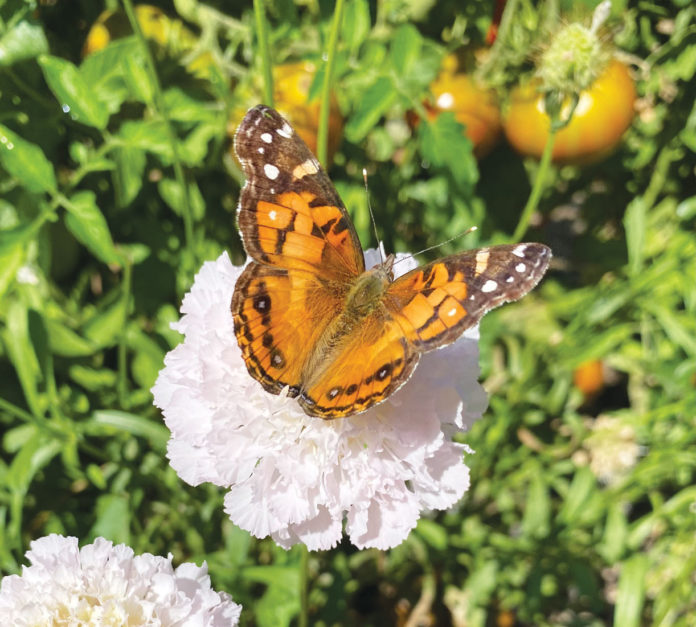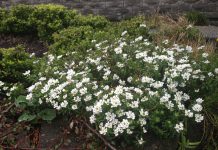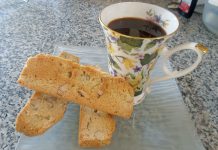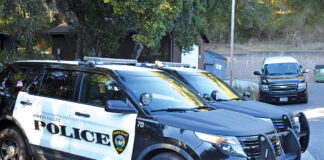Recently we were visited by hundreds of butterflies. I had over 20 drinking from the small puddle near my front door. One made it into the house as they fluttered around me when I opened the screen door. He’s going out today to join the other California tortoiseshell (Nymphalis californica). You would think with so many of these beautiful subjects to photograph, I could have gotten the perfect shot but alas, nary a one landed on any of my nectar-rich flowers, not even the buddleia. They were looking for ceanothus and were soon trending on local social media. Where did they come from and why so many this spring?
The California tortoiseshell butterfly is a common butterfly that lays its eggs on ceanothus. After the CZU fire we have an abundance of this succession plant as the soil-stored seeds germinated after the fire broke their dormancy. These seedlings can account for more than half of the plants present in burn areas. If you’ve visited Big Basin State Park or any of the other burn areas, ceanothus are pretty darn happy with all the extra space and sun they are now getting.
Tortoiseshell butterflies have an interesting life cycle as do all butterflies. With three generations per year, they fly here from the Sierra foothills where they lay their eggs on ceanothus. Then those hatch and feed, morph into butterflies who fly to the foothills to repeat the process. Larval food plants include several species of Ceanothus. Adults feed on flower nectar, sap, fruit and mud. They live for 10 months or more.
The tortoiseshell is no stranger to our mountain. After the Lockheed fire, this same phenomena happened when the ceanothus were head-high. After hatching here they took flight to the mid-elevation Sierra Nevada to lay eggs on a different species of Ceanothus. After that generation denuded the patches of Ceanothus there those adults flew to the highest elevations to eat yet a different species of Ceanothus. Then the adults flew all the way back to Monterey Bay to lay eggs on our Ceanothus and start the cycle over again.
We have about 90 species of butterflies in the Monterey Bay area. Many of these occur only in our mountains, forests and chaparral environments. They are easy to attract and make a permanent feature in your landscape. Here’s how.
A butterfly garden should include plants that accommodate all stages of the life cycle—egg, larvae, pupa and adult. When both adult nectar and larval host plants are available, they will attract and support a butterfly population. In addition to the right plants, your garden should also have sun, a water source, protection from wind and plants in clusters. When maintaining your garden avoid the use of insecticides, including BT.
As adults, most butterflies feed on the nectar of flowers. Some local butterflies, like the mourning cloak and red admiral, feed primarily on rotting fruit or tree sap for moisture and nutrients while the California sister feeds on aphid honeydew.
In the larval stage, most butterfly species are limited to a single plant family and occasionally a single genus. To attract more western tiger swallowtails, for instance, provide larval host plants such as willow, sycamore, alder, big leaf maple, sycamore, plum and ash. Common buckeye lay their eggs on mimulus and verbena while California sister uses the coast and canyon live oak.
Planting a variety of grasses and shrubs like ceanothus, buckwheat, coffeeberry, bush lupine, manzanita and perennials like redwood violet, California aster and wallflower will attract a variety of local butterflies. If your garden is near a wild area that naturally supports the caterpillar stage, you can plant just the nectar plants to attract butterflies to your garden.
Filling your garden with nectar producing flowers is the fun part. Adult butterflies rely on sugar-rich nectar for their daily fuel. Different species have different flower color and shape preferences. Many butterflies produce scents that attract the opposite sex and many of these scents smell like the flowers that they are attracted to and visit. The scent of these butterfly-pollinated flowers may have evolved as an adaptation to ensure their survival.
Butterflies typically favor flat, clustered flowers that provide a landing pad although larger butterflies can feed on penstemon and salvias while hovering. Unlike bees, butterflies can see red and are attracted to brightly colored flowers. Pink, red, orange, yellow and purple are the most attractive nectar source flower colors but they also use blue and white.
Consider the blooming time of each plant. Having plants blooming in the sun for many hours in the day will lengthen your viewing time. Nectar rich flowers include yarrow, aster, verbena, scabiosa, buckwheat, toyon, salvia, erysimum, zinnia, lantana and coneflower.
In addition to nectar, butterflies need a source of water and salts. A patch of mud kept wet year round or a shallow depression lined with pebbles and kept moist will work fine. Also provide some flat rocks for them to bask in the sun in an area protected from the wind by shrubs.
Having a garden filled with birds, bees, butterflies and other pollinators is fun and easy.
Jan Nelson, a landscape designer and California-certified nursery professional, will answer questions about gardening in the Santa Cruz Mountains. Email her at ja******@*ol.com, or visit jannelsonlandscapedesign.com.













